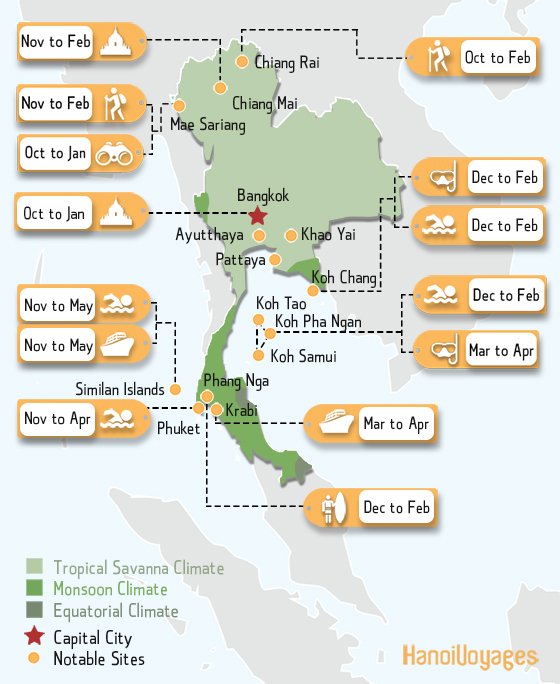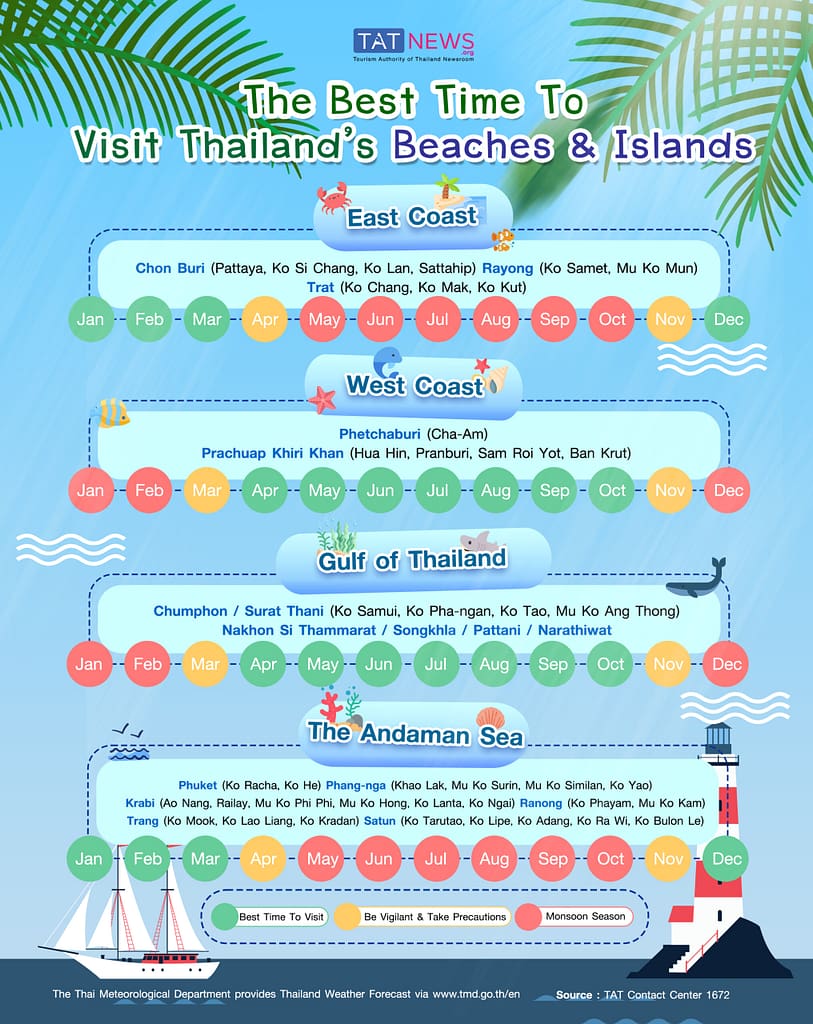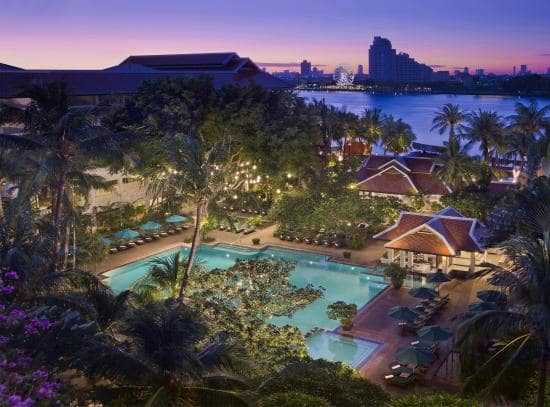Thailand is a dream destination for many travelers. The country’s weather varies greatly throughout the year.
Planning your trip to Thailand involves considering the weather. The best time to visit depends on what you want to do and see. Thailand has three main seasons: cool, hot, and rainy. Each season offers unique experiences, but good weather is key to a perfect trip.
The cool season, from November to February, is often the best time to visit. The temperatures are pleasant, and the skies are clear. This period is ideal for exploring beaches, temples, and bustling markets. Avoid the peak heat of the hot season and the heavy rains of the monsoon season by timing your trip right. Let’s dive deeper into the best times to go to Thailand for the best weather.

Credit: hanoivoyages.com
Introduction To Thailand’s Climate
Thailand is a captivating destination known for its vibrant culture, stunning beaches, and rich history. But before you pack your bags, it’s crucial to understand the country’s climate. Knowing the best time to visit can make or break your trip.
Overview Of Seasons
Thailand has three main seasons: hot, cool, and rainy. The hot season runs from March to June, with temperatures soaring above 35°C (95°F). This is perfect for beach lovers but can be uncomfortable for sightseeing.
------------------------------------------------------------
Book Your Next Asia Experience
Book Your Next Asia Experience
------------------------------------------------------------
The cool season, from November to February, offers milder temperatures ranging from 20°C to 30°C (68°F to 86°F). This is the peak tourist season due to the pleasant weather.
Lastly, the rainy season spans from July to October. While it can be wet and humid, it’s also when you’ll find fewer tourists and lush landscapes. Consider what activities you want to prioritize when choosing your travel dates.
Geographical Influence
Thailand’s diverse geography also affects its climate. The north, with cities like Chiang Mai, experiences cooler temperatures, especially in the mountains.
In contrast, the southern regions like Phuket and Krabi have more consistent temperatures year-round but are more susceptible to monsoon rains. This means you can enjoy beach activities almost any time, but checking the local weather forecast is still wise.
Have you considered how these geographical variations might impact your travel plans? For example, trekking in the north is best during the cool season, while island hopping in the south is ideal outside the monsoon months.
Understanding Thailand’s climate will help you decide the best time to visit. Whether you’re aiming for a sunny beach vacation or a cultural city tour, timing is everything.
Peak Tourist Season
Thailand’s peak tourist season offers sunny skies and pleasant temperatures. November to February provides the best weather for adventures. Enjoy the vibrant culture and stunning beaches in perfect conditions.
Visiting Thailand during the peak tourist season is an experience like no other. The country buzzes with energy, and every corner is alive with vibrant colors and sounds. The clear skies and pleasant temperatures make it a perfect time for adventure and relaxation.Best Months To Visit
The ideal time to explore Thailand is from November to February. During these months, the weather is cooler, and you can enjoy outdoor activities without breaking a sweat. Picture yourself sipping coconut water on a sunny beach or hiking through lush green landscapes without worrying about rain. The cool breeze and clear skies make it perfect for island hopping. Whether you’re wandering through the bustling streets of Bangkok or enjoying a serene day in Chiang Mai, the weather will be on your side. Evenings are crisp and refreshing, ideal for night markets and dining under the stars.Popular Destinations
Phuket and Krabi are must-visits during the peak season. These coastal paradises offer pristine beaches and crystal-clear waters. You can indulge in water sports, or simply relax and soak up the sun. Bangkok is another hotspot. The city is a blend of modernity and tradition, offering everything from dazzling temples to vibrant nightlife. If you’re a food lover, street food stalls serve delicious dishes that will tantalize your taste buds. Chiang Mai offers a different vibe with its mountainous landscapes and cultural festivals. It’s a great place for those who enjoy exploring local traditions and crafts. The Flower Festival in February is a spectacular event that shouldn’t be missed. When do you plan to explore Thailand’s wonders? The peak tourist season awaits with unforgettable experiences.Off-peak Season Benefits
Planning a trip to Thailand can be exciting, but choosing the right time to visit is crucial. While many travelers flock to Thailand during peak season, the off-peak season offers its own unique benefits. Below, we’ll explore the advantages of traveling during Thailand’s off-peak season.
Lower Prices
One of the biggest perks of visiting Thailand during the off-peak season is the lower prices. Hotels, flights, and even tours tend to be cheaper. Imagine stretching your budget further and maybe even indulging in a few extra treats or experiences.
Last year, I visited during the off-peak season and scored a fantastic deal on a beachfront resort. It was a luxury I wouldn’t have afforded during peak times.
Fewer Crowds
Traveling off-peak means fewer crowds. You’ll have more space to explore popular attractions without feeling rushed or overwhelmed. Picture yourself enjoying the serene beaches or wandering through temples without elbowing for space.
When I visited the Grand Palace in Bangkok during the off-peak season, it felt like a private tour. I had the freedom to take photos and absorb the beauty without the usual hustle and bustle.
Have you ever dreamed of having a beach almost entirely to yourself? Traveling during the off-peak season in Thailand can make that dream a reality.
Would you rather save money and enjoy a quieter experience, or deal with higher costs and crowded places? The choice is yours, but the off-peak season certainly offers compelling benefits.
Monsoon Season Insights
Thailand’s monsoon season can be a magical experience, if you know what to expect. While many travelers shy away from visiting during this time, those who embrace the rain might find unique opportunities to explore the country’s lush landscapes. Understanding the weather patterns and planning accordingly can turn a potentially damp holiday into a memorable adventure.
Rain Patterns
The monsoon season in Thailand typically runs from May to October. During these months, the rain can be quite unpredictable. You might experience heavy downpours that last an hour or two, often in the late afternoon or evening.
In the north, expect more consistent rain, while the southern islands might have sporadic showers followed by sunshine. In Bangkok, the streets can flood quickly, but the city has adapted with efficient drainage systems.
If you’re visiting Chiang Mai or Phuket, pack waterproof gear. A rain jacket and quick-dry clothes can save you from being soaked. Keep an eye on weather forecasts, as they can change rapidly.
Travel Tips
Traveling during monsoon season requires a bit of extra planning. Consider scheduling indoor activities like cooking classes or museum visits during peak rain times.
Local markets often remain lively despite the rain. Embrace the chance to enjoy authentic street food under a sheltered stall. You might find that the rain brings out the flavors of Thailand in unexpected ways.
Don’t let the rain deter you. Sometimes, a sudden shower can lead to unexpected adventures, like finding a cozy café or stumbling upon a hidden temple. Ask yourself, are you ready for a spontaneous journey?
Share your travel plans with locals. They can offer insights on less crowded spots that are even more beautiful in the rain. Plus, they know the best times to visit popular attractions to avoid the crowds.
Remember, the monsoon season can offer a different perspective on Thailand’s beauty. Your willingness to adapt can lead to unforgettable experiences.
Dry Season Adventures
Thailand’s dry season offers perfect weather for outdoor adventures. The months from November to April are ideal for exploring this beautiful country. Clear skies and mild temperatures create the best conditions for enjoying various activities. Whether you want to hike through lush forests or relax on sun-kissed beaches, the dry season is the time to visit.
Outdoor Activities
Thailand is a paradise for outdoor enthusiasts. The dry season is the best time to enjoy trekking in Chiang Mai’s mountains. The trails are dry, and the views are stunning. If you love water sports, try kayaking in Krabi’s emerald waters. The calm seas make it safe and fun. For those who prefer a laid-back experience, cycling through the countryside offers a peaceful escape.
Beach Destinations
------------------------------------------------------------
Book Your Next Asia Experience
Book Your Next Asia Experience
------------------------------------------------------------
Thailand boasts some of the world’s most beautiful beaches. During the dry season, destinations like Phuket and Koh Samui are ideal. The weather is perfect for sunbathing, swimming, and beach volleyball. The clear blue waters are inviting for snorkeling and diving. Visit the Phi Phi Islands for a breathtaking underwater experience. The dry season ensures calm seas and great visibility.

Credit: www.facebook.com
Festivals And Events
Thailand is famous for its vibrant festivals and events. These celebrations often coincide with the best weather periods, making it a perfect time to visit. The country’s rich culture comes alive during these times, offering a unique experience for travelers.
Cultural Celebrations
Thailand hosts many cultural celebrations throughout the year. Songkran, the Thai New Year, is one of the most famous. It takes place in April and involves water fights and traditional rituals. This festival marks the end of the dry season and the start of the rainy season. Loy Krathong, held in November, is another significant festival. People float decorative baskets on rivers to pay respects to the water spirits. It’s a beautiful sight with thousands of lights reflecting on the water.
Local Traditions
Local traditions in Thailand are deeply rooted in history. The Yi Peng Lantern Festival in Chiang Mai is a must-see. Held in November, it features thousands of lanterns released into the sky. The event symbolizes letting go of misfortunes and making wishes for the future. Another local tradition is the Phi Ta Khon Festival in Dan Sai. Known as the Ghost Festival, it involves parades, music, and dancing. This festival happens in June or July and celebrates local folklore and spirits.
Regional Weather Variations
Thailand’s weather varies greatly by region. Understanding these variations can help you plan your trip. Let’s explore the regional weather differences in Northern and Southern Thailand. This will help you find the best time to visit.
Northern Thailand
Northern Thailand has three main seasons: cool, hot, and rainy. The cool season runs from November to February. It’s the best time to visit. The temperature is mild, and there is little rain. From March to May, the weather gets hot. Temperatures can reach 40°C. June to October brings the rainy season. Expect heavy rains and high humidity. The landscape turns lush and green.
Southern Thailand
Southern Thailand has a tropical climate. It experiences warm weather year-round. The region has two main seasons: wet and dry. The west coast, including Phuket and Krabi, gets rain from May to October. The east coast, including Koh Samui, has its rainy season from November to April. The dry season is the best time to visit. You can enjoy sunny days and calm seas. The weather is perfect for beach activities.

Credit: santorinidave.com
Packing And Preparation
When planning your trip to Thailand, packing and preparation are crucial. Good weather means you need to be ready for sunshine and occasional rain. Proper packing ensures you enjoy your trip without any hitches. Here are some essentials for your Thailand adventure.
Clothing Essentials
Lightweight clothing is a must. Think cotton shirts and dresses. These keep you cool and comfortable. Pack shorts and skirts for daytime. They help you stay cool in the heat. Don’t forget swimwear for beaches and pools. Bring a hat and sunglasses for sun protection.
Comfortable walking shoes are vital. You will explore many places on foot. Pack flip-flops for the beach. A light jacket or sweater is useful. Nights can be cooler, especially in northern Thailand. Pack a raincoat or umbrella. Rain showers are common during certain months.
Travel Gear
A good backpack is essential. It should be lightweight and durable. Use it for day trips and excursions. Pack a reusable water bottle. Staying hydrated is important in the heat. A small first aid kit is useful. Include band-aids, pain relievers, and any personal medications.
Don’t forget your travel documents. Passports, visas, and travel insurance are crucial. Keep them in a safe, accessible place. Pack a power bank for your gadgets. It ensures your devices stay charged. A travel adapter is needed for your electronic devices. Thailand uses different plug types.
Lastly, pack some snacks. They keep you energized during long trips. Granola bars, nuts, and dried fruits are good options. They provide quick energy and are easy to carry.
Frequently Asked Questions
What Is The Best Month To Go To Thailand?
The best month to visit Thailand is November. The weather is cool and dry, perfect for exploring. Enjoy festivals and beach activities.
What Is The Rainy Season In Thailand?
Thailand’s rainy season typically runs from May to October. Heavy rainfall and occasional thunderstorms are common during these months. Travelers should plan accordingly and expect some disruptions due to weather conditions.
Which Month Is Best For A Thailand Trip?
November to February is the best time for a Thailand trip. The weather is cool and pleasant.
What Are The Best And Worst Months To Visit Thailand?
The best months to visit Thailand are November to February. The weather is cool and dry. The worst months are April and May due to extreme heat, and September to October because of heavy rains.
Conclusion
Thailand offers diverse weather for every traveler. Dry season is ideal for sun seekers. Visit from November to April for sunny days. The wet season, from May to October, brings lush scenery. Perfect for those who love green landscapes. Each season offers unique experiences.
Plan your trip based on your weather preference. Enjoy vibrant culture and stunning beaches. Thailand’s beauty awaits in every season. Remember to check local weather updates. And pack accordingly for a memorable trip. Whether sun or rain, Thailand promises adventure and charm.




